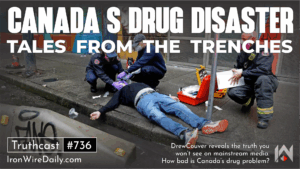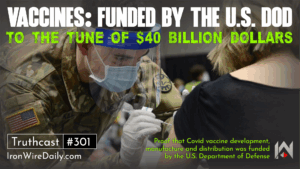StatsCan Hoisted By Their Own Petard; Pandemic Does Not Exist | Ken Drysdale
September 3, 2022
- What are the true facts?
- What can we learn from the data in 2020 before the shots?
- What is happening with Ken’s request for an investigation?
- What is the Truth Event?
- How can we use the tremendous power of strength in numbers?
Investigation into Criminal Allegations Concerning Covid-19 Pandemic Response – Citizens For Truth
Please share on your social media accounts
Will: [00:00:00] My guest today, Ken Drysdale spent over 40 years in the construction industry as a professional engineer. He founded and operated until his retirement in 2016 ACU Tech Engineering, Inc, which remains to this day as the most recognized name in Arctic development in Canada, he is an applied scientist and a Fellow of Engineers, Canada.
Ken has received a number of awards, including the Canadian Consulting Engineers Award for design excellence, twice and the inventor of two proprietary engineering systems. His areas of expertise include forensic and structural engineering, multidisciplinary project development and execution, as well as scheduling cost estimating and construction inspections.[00:01:00]
Ken is a recognized expert in projects in the high arctic having spent over 25 years working on projects across Canada’s Arctic territories. He has completed dozens of detailed forensic engineering reports and has appeared as an expert witness on several occasions in Manitoba’s Court of the Queens Bench.
Ken is also a member of Citizens for Truth and the author of the 89 page report investigation into criminal allegations concerning COVID 19 pandemic response, which uses data directly from Statistics Canada, to prove beyond doubt, there is no COVID pandemic and there never was. Ken, welcome to the Show.
Ken: Thank you. I appreciate having this opportunity to talk to your audience.
Will: Now I had the pleasure to watch a couple of your previous interviews especially the one with the Canadian COVID Care Alliance, where you shared much of the data that you found when you compiled this report. And of course, a big part of my point of your intro was to introduce people to the idea that you are a consummate researcher.
[00:02:00] You’ve been doing this your whole life, looking up data, analyzing data. And that’s exactly what you’ve done here is you’ve pulled data directly from Statistics Canada, and demonstrated, I think, beyond any doubt thar, there is no pandemic there just absolutely isn’t. And so I’d like to invite you now to share that data with our audience, and then I’m gonna have some questions for you possibly as you go through.
And certainly when you’re.
Ken: Okay. First off, I guess I should give just a little bit of an explanation of what our report is because there’s all kinds of reports floating around the internet and all kinds of experts with all kinds of opinions. Some are very good and some are very understandable and believable and some not so much so on all sides.
So we didn’t want to get into the quagmire of saying that our experts are smarter than your experts. So when I was considering what to do with this report, I decided to use the government’s own words as they spoke them. And so I went to Statistics Canada, and I actually took all of their mortality numbers along with some additional information from Canada and the government of Manitoba to have one of these reports [00:03:00] done in Ontario as well now.
And so we didn’t debate the government’s own numbers. In other words, when the government said that there were 10 deaths from COVID, we didn’t argue, we didn’t say you’re testing is faulty or was that with COVID? Was it because of COVID we just took their numbers. So to talk about the numbers, what we did was we compared
previous years prior to 2020, like 2019. And we compared those mortality numbers to 2020’s mortality numbers. And of course, 2020 is when they first reported the pandemic hitting. And so you would expect that you would get the most number of casualties in that first year, because of course they wouldn’t necessarily have treatments.
They wouldn’t know what they were dealing with. And the most vulnerable would’ve still been they wouldn’t have died already, if everyone recalls, the government was saying things to us like boy, if you’re 70 years of age and older, you’re 80 years of age and older, this getting a COVID 19 is like a death sentence in [00:04:00] 2019.
And this is a little more scary for me than most folks because I’m getting to that age . But if you were 70 years of age and older in Canada in 2019, There were about four and a half million people above the 70 years of age and older. And during 2019 before the pandemic almost 146,000 people died. That meant that your chance of dying, if you were 70 years of age older in 2019, for just whatever reason, obviously not COVID cuz it hasn’t occurred yet.
We’re 1 in 32 so in one year, your chance of dying, if you were 70 years of, but prior to the pandemic was 1 in 32, I was actually shocked that I was that high. In 2020, according to statistics of Canada, 14,400 people or so died of COVID 19 in that age group. So if you just do the the sub the division, again, your chance in 2020 of catching COVID 19, if you were 70 years of [00:05:00] age and older dying from it were 1 in 324.
So that’s, so your chances of just dying for any reason prior to COVID were 10 times higher than your chance of catching COVID and dying of it during the peak time of the pandemic.
Will: Now you said that in 2019, the odds of dying for if you’re 70 years of age or older is 1 in 32, correct?
Ken: Correct.
Will: And then you calculated that in 2020, your odds of dying over the age of 70 from COVID were I believe what 1 in 324?
Did you calculate the overall odds of dying in 2020? And to compare that to 2019 to that 1 in 32.
Ken: You mean for the whole population?
Will: Yes. For, oh yeah, just COVID. Everything all causes. What figure did you come up with?
Ken: Oh, you know what I haven’t got that in front of me, however, It’s not really any different,
Will: Than what’s expected?
Ken: Yeah. What we did in the report. It’s really something [00:06:00] interesting here. One of the things that the government did to fool you now, I say that, and I might be wrong. Maybe they’re just incompetent. But what they did was they showed total death rates in Canada from 2006 and on, and they kept saying to you that year over year, there were more deaths in 2020 than the previous year, 2019.
Now there’s a lot the matter with what they were saying. First, the population of Canada increases about a half a million people every year. So you would expect if, even if the death rate, in other words, a number of people dying per hundred thousand or per thousand, even if that rate remains constant, you would still have a year over year increase in death because the population went up by a half a million people.
So that was the first trick that the government used, they said to you that, year over year, there were more deaths in 2020 than 2019. The other thing, and it was really interesting and [00:07:00] we actually had a graph in our report and you know what, I think it might be worthwhile for me to just display that.
So I’m going to, I’m just gonna find it here on my screen and I’m gonna display that. Ah, here it’s. So I’m gonna share my screen and hopefully I get the right screen. Okay. Can you see that screen now?
Will: Yes, we can. Thank you, ken.
Ken: Okay. What this is, this is what, the–, how the government reported overall mortality in Canada during the pandemic.
And you can see I’ve got in the vertical 2006 to 2020. The next column is the population at, so in 2006, there were 31 million people in Canada. In 2020, there were 38 million. So you can see that the population moved up 7.5 million people. So in order to understand the deaths, the overall mortality, you have to adjust those numbers so that you’re comparing apples to apples.
And so in this column, and again, these, what you’re looking at right now are completely unadjusted numbers. So this second [00:08:00] column, third column is actually the number of deaths per year. And you could see that it went in 2006, from 225,000. In 2020, all the way up to 300,000. But once again, there were 7 million, more people or 7.5 million more people in 2020 than there was in 2006.
And in this column it shows the change. And you’ll notice that of course, year on year, like in 2019 to 2020, the number deaths did in fact go up. Yes. And you can see here that, sorry. I was saying that the population went up by half a million. That was an average. You can see that from 2017 to 2020, it went up by three quarters of a million people.
And that was accounted for by a significantly increased immigration into the country.
Will: Once again, for a quick question. In the overall change of population column we’re seeing the number, the same number repeated quite a many number of times. May I assume that is because they don’t do a census every year. And so you’ve taken the census [00:09:00] figures and divided it by the increase since the last census.
Ken: Yes. Actually I didn’t do that. Statistics Canada actually did that calculation and they give it to you. And so between the censuses that when taking census, they actually do an estimate themselves. So I use their estimate. Those are their numbers, not mine.
Will: Okay. Thank you.
Ken: So this chart now, of course, remember we talked about, you have to adjust it for a bunch of things. You have to adjust it for the increase in population. So the next page, that’s what we’ve done here. So what we did was in 2006, for instance, there were 31 million people, but we adjusted the number so that all of the years were at 38 million people.
And simply all you do is you increase by the same proportion. The population number to the target population number so that you’re looking at apples and apples. We could have done this another way. We could have expressed it as so many deaths per 100,000, but we decided to do it this way the answer is still the same.
When you, now, when you analyze this and we, and right [00:10:00] underneath it, there’s a table here. It might be worthwhile for me to just increase the size of my screen a bit because it’s, that’s this table’s very important. And again, page 23 of 89 pages. What this is looking at the adjusted numbers
and the blue columns are the total mortality is, in the year. And you can see that from about 2014, all the way up to 2018, there was a steady increase in the number of deaths or total mortalities in Canada from 2014 to 2018. But then look what happens at 2019, just before the pandemic. There’s a significant drop.
This blue line is actually, it’s a, it’s what they call a trend line. What it’s doing is it’s basing it’s. It created a curve that predicts what the expected deaths would be based on the deaths in the years that had happened before. So as if nothing happened, nothing special would happen. [00:11:00] This blue line estimates where the death should have been.
So once again, from 2014, all the way up to 2018, the deaths you can see were increasing at a fairly consistent rate. And then in 2019, just before the pandemic, bang, it drops somewhere between 5,000 and 6,000 deaths. And then in 2020, bang, it increases by about 6,000 deaths. Now the statistics for 2019, weren’t available until well into 2020, just like the statistics for 2021 aren’t even available yet in August of 2022.
Now. I can’t tell you. And I won’t tell you that somebody’s cooked the books here, but that’s quite a coincidence and the numbers are very close. There’s actually an explanation on the following pages that actually take you through the numbers. And you can see that in 2019, there were 5,400 less deaths.
And [00:12:00] in 2020, it was almost an identical number, 6,260 additional deaths. They balanced each other out. And the trend was for the death to be going up every year. So there’s a couple of things here. One thing is the government, when they reported to you that death year over year went up. That is true, but you had to account for the population increase.
And then secondly, what was happening here? What happened in 2019 that we bucked a trend, and somehow came up with a number that was almost identical to the rate, the rise in death they reported for the next year? And I don’t know what the definitive answer is for that, but those are what the numbers are telling you.
Will: I do have one possible explanation that I’ve received from some of the other experts that I have interviewed. Something that our government never bothered to tell people was that 2019 was a weak flu year. There were no virulent strains of flu that year. And anytime that happens, and you can go back [00:13:00] through the statistics for the last 20 years
and you can see several times where this happened. What happens is that the elderly people, the vulnerable population who would have died from a virulent strain of the flu survived that year and then died the following year. Because the other thing they didn’t tell people was that in 2020 H1N1 was active.
So that right there would account for the drop in 2019. And the subsequent jump in 2020 had nothing whatsoever to do with COVID.
Ken: There’s a lot of interesting things that happen there. As I live in Winnipeg and generally speaking in the wintertime, if you get a storm and people are blocked up at home for a day, nine months later, there’s a small baby boom.
Between 2019 and 2020, there were actually a drop of 11,000 births in Canada. This is when people were all locked up. You would’ve thought that they would’ve gone up, but again, I haven’t heard anybody question it. I’ve seen no studies. Maybe there are, and I just haven’t found them. But you think that would be a pretty big deal, but considering
that [00:14:00] even the way the government reported COVID deaths, they reported, I think 16,000 deaths in 2020 or something that they said was part of COVID. So 16,000 deaths, but they didn’t, no, one’s asked the question about 11,000 less babies that were born.
Will: Actually they have, I’ve interviewed two experts recently on that Christof Plothe in Germany and Dr. Jessica Rose. They are both experts in analyzing the various database and infertility itself. And what’s happening is that these shots are sterilizing people. In fact, in Taiwan alone, Dr. Plot showed that there was in the last year, a 22% drop in birth rate in one year. Yes. So that was happened.
This is a little different because remember this was the data for 2020.
So the shots didn’t come out until in Canada until I dunno, December 11th or 15th or something.
So I’m sorry, I just wanna make sure I’m getting this clear. So what you’re saying is that in late 2020, because the lockdown started in [00:15:00] February, March of 2020, we should have seen a jump in birth. But we didn’t and you’re absolutely right.
It wasn’t until December of 2020 that they started ruling out the shots. Yes. So that can’t be the explanation for that. So thank you for correcting me on that. You’re absolutely right. That is mysterious.
Ken: Yeah. And, and you’ve pointed out a really good point too, apart from the obvious fact that 2021 data still isn’t available, provisional data’s available, but real data’s not out.
We were forced into just looking at 2020, but there’s actually a 2020 data is actually unique because it hasn’t been affected by the shots because it didn’t come out till December. And it again was the year when this tsunami, if you want slammed into the population. So that would’ve been the year that you expected the most damage.
And according to the provisional numbers, the Statistics Canada for 2021 that is indeed correct. So these numbers [00:16:00] we’re talking about are unaffected or unprejudiced, if you will, by the shots because they’re for 2020.
Will: Right. Now, thank you very much for sharing that information for the research that you’ve done.
We had actually done something quite similar ourselves, but what we did was we calculated the death as a percentage of the population. And I’m quite sure that your method was, is definitely better because you are an expert in that area, but you found exactly the same thing that we did when we did this analysis.
So now I wanna talk about the purpose of the document itself and obviously the title of the document investigation of criminal allegations concerning COVID 19 pandemic response is a clue. What you were wanting to do with this document was to urge the police, to launch a criminal investigation, which you are now pursuing in Manitoba and Ontario and with the RCMP, could you please give us an update on how that’s going?
Ken: That’s been really interesting. We didn’t expect we were gonna write this report and every police force in the country was gonna jump on and go, oh my goodness and do their job. We’re not I might look that way. I was born on a farm, but I’m not now I’m gonna [00:17:00] get a bunch of hate mail from farmers.
I live in a country
and I’m a farm boy, and I’m proud of it in any case. You’re right. In my experience, in, in forensic reports, generally speaking, if a company, for instance experiences of fraud, somebody commits fraud against them. The police just don’t go out, looking for that and investigating it.
And so normally what happens if someone -a corporation or a person has had fraud put against them. They’ll hire their own lawyers and their own accountants. And they’ll do a forensic report, similar to what we did. It won’t be complete from top to bottom, but it’ll be enough to prove, to indicate that there’s a good chance that there’s some wrongdoing here – some illegal or wrong ongoing, then they what they do is they take that report to the police and the police initiate a real, like a full scale investigation.
So that’s what we did here. This is not intended to be a complete report that would take my lifetime because I can tell you when we were writing it every time I looked under a rock, it was rotten and it just got to the point where I had to [00:18:00] stop, because you’re looking at one thing that would lead to a next question.
And you would look at that. So prepared this report to be the seed, if you will, for the police. And I’m just gonna share my screen again, because folks could see that from the table of contents. So this is the cover that’s on the screen right now. These are the tables of contents. So you can see that there’s a we have a section called requirement for the police to act.
So what we do there is we go into the legislation that sets out what police are supposed to do. We tell them what we think the alleged crimes are. We tell them, or name people who we believe are involved or the alleged perpetrators. We tell them when the crimes happened, we’re not necessarily suggesting that everyone knew when it first started, but by the time the statistics were available, then the experts and the medical profession knew or ought to have known what was going on
and they continued. So it was at that point, we said the crimes occurred. And then we get [00:19:00] into this part, which is statistics and some of the things that we’ve already been talking about. So this thing was, again conceived to be a seed for the police to act? No, the question is what’s happened. So we finished a report in April and in mid April, we sent the report out by registered mail to every single police detachment in Manitoba.
We delivered it to every single member of parliament, every member, every Senator, and every member of the Manitoba legislature. Once we did that. The public started to catch wind of this. And again, that wasn’t our original intent, but the public started to catch wind with this. And so folks started asking for it.
So we set up a website in early June. And I think that website is about 80,000 unique visitors, maybe just a little under 80,000 unique visitors. So that’s what we did in Manitoba, but then across the country from coast to coast, I get emails many, probably hundreds of emails a day from folks right across the country.
People are delivering this by [00:20:00] hand to the OPP to the Hamilton Police, to the Victoria Police, to the Calgary Police, and it’s happening right across the country. We had two folks go into a, an RCMP detachment just south of Manitoba and the police officers started swearing at them. Had didn’t have his ID on and chased him outta the building was gonna arrest.
We had the City of Winnipeg Police. The it was the chief of staff when he got the report, because we’re also working with various police groups. We’re working with Police for Freedom, Police on Guard. And so we have members, retired police officers going in and doing some of this work. In any case, the City of Winnipeg Police said it was an excellent report.
And we said, so when you gonna investigate it and they said we need, we should meet with you. So we tried to set up a meeting over several weeks and they wouldn’t. And then we followed up with him. They said, the city of Winnipeg police can’t accept a complaint from Mr. Drysdale because he’s not a resident of the city of Winnipeg.
And we went, ‘What? You mean if someone who doesn’t live in Winnipeg is walking down the sidewalk and they see somebody murdered the City of Winnipeg Police are [00:21:00] saying they won’t take evidence from that person?’
Will: Yeah. That’s very puzzling. I’m no lawyer or police officer, but I always understood that allegations would be filed in the jurisdiction in which the crime happened, not where the victim lives.
Ken: Anyway, apparently one of our reports showed up in the mailbox at one of some judges’ home. Now I don’t know why that would be illegal, but it did. And I had nothing to do with it. But the irony is that the Winnipeg Police are phoning me a week or so later asking me for evidence on an alleged crime in Winnipeg when I’m not a Winnipeg resident.
So how does that work?
Will: So you’re qualified to give them evidence when they want it, but not when they don’t.
Ken: And the RCMP weren’t much better except they were you can think about what you want to think about, but we went through a similar process with them and we were getting somewhere and we were communicating directly with an individual and first the R CMP said that they hadn’t even heard of it. Now, keep in mind, this went out by registered mail to, I don’t know how many detachments there are in Manitoba, [00:22:00] probably 30 or 40. I can’t remember. In any case, we’re keeping inching forward.
We’re gonna have a meeting. And then when we phoned to confirm the meeting, the RCMP representative goes, I’m out. And we said what I’m out, I’m not dealing with this anymore poop. And , and now I can’t remember if it was an OPP station or a Hamilton police station. This just happened the other day. One of our subscribers walks in with a report and the police tell our subscribe, oh, you can’t refer charges.
What? You can’t bring evidence of a crime to this police station. They don’t accept that. That’s what they said. That’s been going over all over the country. Some police officers or some police stations have been accepting the report and some have been chasing people out in response to that.
We created a blog post in cooperation with retired police officers about how to do this, go in with more than one person, be respectful. So there’s a blog post on our website that talks exactly about [00:23:00] how you should approach the police. One of the things we’re trying to do, we’re trying to wake Canadians up.
We’re trying to give them information. And then we’re also trying to give them a toolkit that they can use to do things in their own community, similar to what we’re doing. So the next stage of this is again to wake Canadians. On September 3rd in the City of Winnipeg, we’re having folks gather at the RCMP headquarters division building at 1 p.m. In the afternoon and have a copy of the report with them have on a white t-shirt that says truth on it.
And we’re gonna present this thing to the RCMP, but regardless of what the RCMP do, and I’m not being secretive about this. We will be able to use that to educate and wake up Canadians. We’ve asked everyone in attendance to be a reporter and film and photograph everything and report on it, send it out on the social media.
So if the RCMP come out and do their job and accept the report that’ll tell one story and then it’ll start the next stage. Next stage being [00:24:00] okay. What’s the status of the report? How are the investigation? How’s the investigation going? Who’s in charge of it. If they don’t come out, we’ll use that to do another, to take it in another direction and educate people again.
So regardless of what happens, this is gonna be a win for us. Yeah. Regardless of what happens. And I say that strongly because folks, we’ve been at this for two months and I get emails from folks right across the country who are going well, what’s happened so far. Have you done it?
Is there an investigation? And I say, listen guys, it’s they did, it took them years to do this to us. And we’ve only been at this two months, but look at all the successes we’ve had. And again, we did a blog post on that and we listed all the successes. Everything that’s happened, what we’re planning to do now we’re planning this
event for the RCMP only in Winnipeg right now, September 3rd. That’s it. But there’s a reason for that. Remember I said, we’re trying to create a website people can use as a toolkit. So when we’re done, we’re gonna have a button on that website. You’ll be able to push it [00:25:00] and it’ll download into your computer posters, notices to the police, notices to citizens, promotional posts, everything you need every little bit that you need, like a promo
for you to stage one of these in your own city. And in addition to that, if we did it across the country at the same time, you’ve gotta believe that if something goes wrong in one city, any one, the press are gonna be all over that. And it’ll, they’ll smear us all. So by doing it one city at a time, each one’s independent and we can improve for the next one.
We can also ensure that we’re all not smeared. If the press tries to do that, It will put us into the public eye on an ongoing basis. You do it all at once. They see you once you do it this week and two weeks from now and a week after that, you keep coming up into the public eye. So again, with the idea of us providing education, waking folks up and providing a toolkit for them, and that’s the strategy of what’s going on September 3rd in Winnipeg
Will: sounds good. Ken, do you have [00:26:00] legal representation? Are there lawyers?
Ken: Yes and no, we’re certainly associated with a lot of different lawyers. I do, I have retained legal counsel just in case legal counsel. And that’s where we’re at right now with regard to protection, if you will.
Will: All right. Ken, thank you very much for all the time that you’ve put into this excellent document. Folks as always, there will be links directly beneath this interview on our website to The Citizens for Freedom website, where you can get all of this documentation. I would urge you to take time to look over this document.
It’s 89 pages long, but the highlights do not take that long to read the charts are very easy to spot, and they’re very easy to understand and keep in mind, this is data directly from Statistics Canada, proving that there is no pandemic there never was. And this is extremely important to be showing this to those who might be sitting on the fence suspecting maybe, but they’ve been misled.
This is the way to show them they have definitely been misled. Ken, thank you so much [00:27:00] for everything that you’ve done for the time you’ve taken for this interview. And I wish you great success with this strategy and our own organization. You and I are gonna discuss what we might be able to do to assist in that effort.
Ken: Wonderful.
Thank you very much. Hope to see everybody out on September 3rd in Winnipeg.
Will: If you found this content informative, I’m going to ask you to go to our website at StrongandFreeCanada.org and sign up for our newsletter. It only takes a minute of your time. With all the censorship bills our government is pushing through the legislature, email is the only way you can be certain of continuing to receive the interviews, videos, and other resources that Strong and Free Canada provides.
In addition, due to censorship, some content is released only on our website while this content is free. Subscribing to our newsletter is the only way you will know. Secondly, if you are able, please donate to our efforts. We have several options on our website for this, including two different [00:28:00] options for offline donations.
We are fighting for the rights and freedoms of all Canadians and have been doing so since August of 2020, but we are also fighting to save lives. Dr. Robert Malone, the inventor of mRNA technology has predicted that by 2028, 700 million people will die globally from the toxic injections that are being falsely marketed as vaccines, and even more sadly, many of those deaths and severe injuries will be in children.
We are working desperately to save as many as we can, and your donation will save lives. Finally, if you yourself have been deceived or coerced into receiving these injections, you will find our treatment protocols at our partner organization, the World Council for Health, which will help to clear the spike proteins and lipid nanoparticles from your body.[00:29:00]
I urge you to also visit WorldCouncilforHealth.org.
Want Your Country Back?
We are in desperate need of monthly recurring donations so we can hire assistants to create more tools in a timely manner. Donate below!
Can You Donate Monthly?
Please consider making your donation monthly. This allows us to make commitments to produce tools and content we otherwise cannot.









